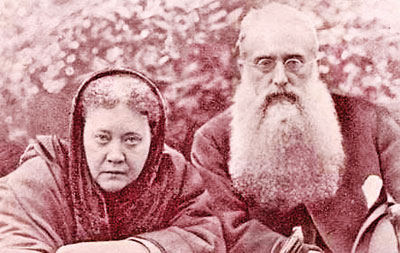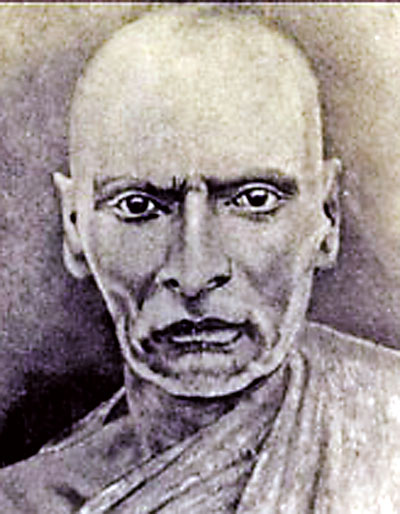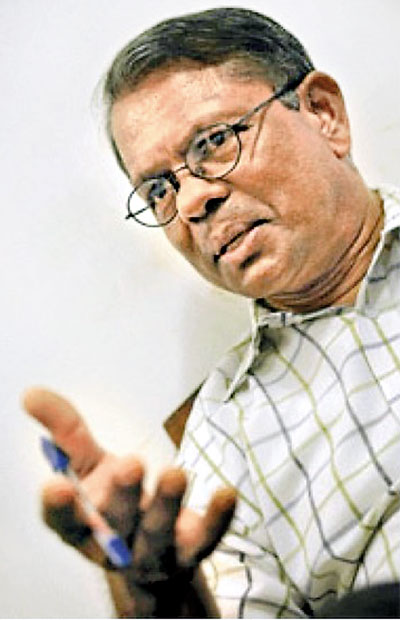Sri Lanka, ambassador for Buddhism over the years

Henry Olcott and Madame Blavatsky: Architects of the Buddhist Theosophical Society of Ceylon
The universally relevant Buddhist prayer, sabbe satta bhavanthu sukhitatta (may all living beings be happy) transcending religious and ethnic barriers expounded by Lord Buddha 2600 years ago, has remained valid to this date as Sri Lanka prepares to host the 14th UN Vesak Day celebrations on the theme of ‘Buddhist Teachings for Social Justice and Sustainable World Peace’. The notions of social justice and sustainable world peace which could only be attained through virtuous human behaviour had been proliferated in the Noble Eight-fold path and suttas such as Vasettha Sutta which articulates that mankind is biologically the same and divisions in human society are mere classifications. The Kanhakatthala Sutta states that when people are given equal opportunities irrespective of their caste, creed or other social parameters, they will perform equally well.
Sri Lanka’s contribution to world Buddhism spanning 23 centuries, is shaped by multiple events and individuals who became catalysts in the revival of the Buddhist tradition since the time of our ancient monarchs to more contemporary Buddhist scholars, philosophers and statesmen. Buddhist scholar Dr. Ananda W.P. Guruge delivering a lecture in 2015 (the first in a series of public lectures to mark the 2600 Sambuddhatva Jayanti) titled, ‘Sri Lanka’s role in the spread of Buddhism in the world’ notes: “In no other country has Buddhism had an unbroken presence extending to over twenty-three centuries.”
Elucidating on the significance of this year’s Vesak celebrations, Prof. Asanga Tilakaratne, from the Department of Pali and Buddhist Studies, University of Colombo and committee member, UN Vesak 2017, says: “It is an expression of Sri Lanka joining the world Buddhist network in a very big way and as a host country of this year’s UN celebrations, it’s particularly of significance to us as the call for Vesak to be accepted by the United Nations General Assembly (UNGA) in 1999 came from Sri Lanka when the former Minister of Foreign Affairs, Lakshman Kadirgamar, tabled a proposal at the UNGA requesting for the adaptation of Vesak Day and at the 79th Plenary Meeting of the UNGA on 15th December in the same year.”
The Vesak Day resolution was adopted as 54/115 on December 15, 1999 and implemented for the first time in 2000 at the UN Headquarters in New York with the representatives of 34 countries. In 2016, the Vesak Day was declared as an ‘Optional Holiday’ by the UN for the first time. “This year as the host country of UN celebrations, we will be lobbying again for Vesak to be a UN declared international holiday in keeping with what the late visionary leader championed,” notes Prof. Tilakaratne.

Ven. Welivita Saranankara Thera: Played key role to re-establish Upasampada here
The seeds of contemporary Buddhist revival in the country as the Buddhist scholar explains, were sown as far back as the mid 18th century. “Although many trace its beginnings to the arrival of Theosophists, Colonel Henry Steele Olcott and later Anagarika Dharmapala who was greatly influenced by the former, the Buddhist revival during colonial rule can be traced back to the times of Ven. Welivita Saranankara Thera who persuaded King Sri Vijaya Rajasinha to bring monks from Thailand to re-establish Upasampada or higher ordination in the country.” Welivita Saranankara Thera worked to reform the Sangha by resuming practices such as pinda patha (alms begging) and his followers were called Silwath samagama or the company of pious ones. The reforms of the learned Buddhist monk also led to the founding of Siyam Nikaya with its headquarters in the Kandyan monastries of Malwatta and Asgiriya.
The founding of Parama Dhamma Chethiya Pirivena, Ratmalana in 1845 was another milestone during this period, followed by Vidyodaya and Vidyalankara pirivenas as Buddhist institutions of higher studies. “The establishment of Dodanduwa School for both Buddhist girls and boys by Dodanduwe Piyaratanatissa Thera long before the Buddhist Theosophical Society of Ceylon initiated several Buddhist schools, speaks of the progressive mindedness of our learned monks. It also mirrors the fact that equal education for men and women was never a taboo in our country,” observes Prof. Tilakaratne.
The middle and late 19th centuries saw a revival in Buddhism led by a new elite emerging under the colonial system and intelligentsia comprising both laymen and the clergy. It is also interesting to note that some of this intelligentsia were educated in Christian missionary schools. The series of public debates between Buddhist monks and Christian priests held between 1860 and 1870, among which Panaduravadaya led by Migettuwatte (Mohottiwatte) Gunananda is well known, also fuelled a newfound zest to revive the traditions.
The establishment of the Buddhist Theosophical Society of Ceylon by Colonel Henry Olcott and Madame Blavatsky was a turning point as this became a voice for the Sinhala Buddhists. “Since the architects of this society and later their follower, Anagarika Dharmapala were fluent English speakers, they could lobby for the Buddhist interests in this country, by being heard by the British rulers,” says the scholar who cites the feats such as gaining recognition for Vesak as a national holiday for the first time and creating a Buddhist flag, facilitated by this forum.
The Pali-English Dictionary which was published in London in 1875 by Robert Childers, based on the lexicographical work of Waskaduwe Sri Subhuti Nayaka Thera further gave Buddhism the international drive. The lay organisations which rose in the country including the Maha Bodhi Society, the Young Men’s Buddhist Association (YMBA), All Ceylon Buddhist Congress and World Fellowship in Buddhism (WFB) which was the brainchild of Prof. G.P. Malalasekera also propelled Buddhism to gain international attention. The Buddha Jayanthi celebrations of 1956 also became a turning point.
“Over centuries as a nation we have been global ambassadors of Buddhism in diverse capacities and this year’s celebration of UN Vesak as a host country is a means of reaffirming it and taking the sublime message of Dhamma to the entire world,” reflects Prof. Tilakaratne who notes that the time had come to make Buddhist philosophy present in every aspect of governance including economic, environmental and social planning. “A culture is never underdeveloped. It’s the human being who becomes underdeveloped due to his lack of will to do the correct thing, to make correct decisions on behalf of fellow human beings. Buddhism guides anyone to make wise decisions and choices,” he adds.

Prof. Asanga Tilakaratne


